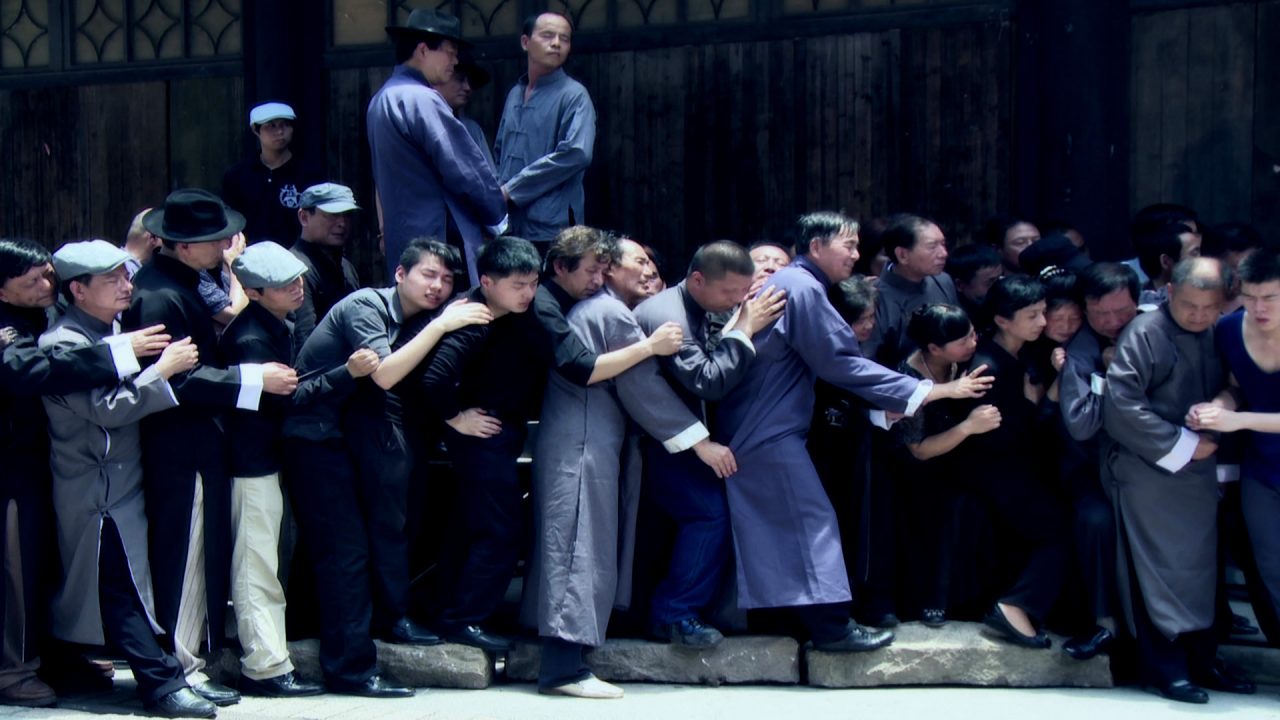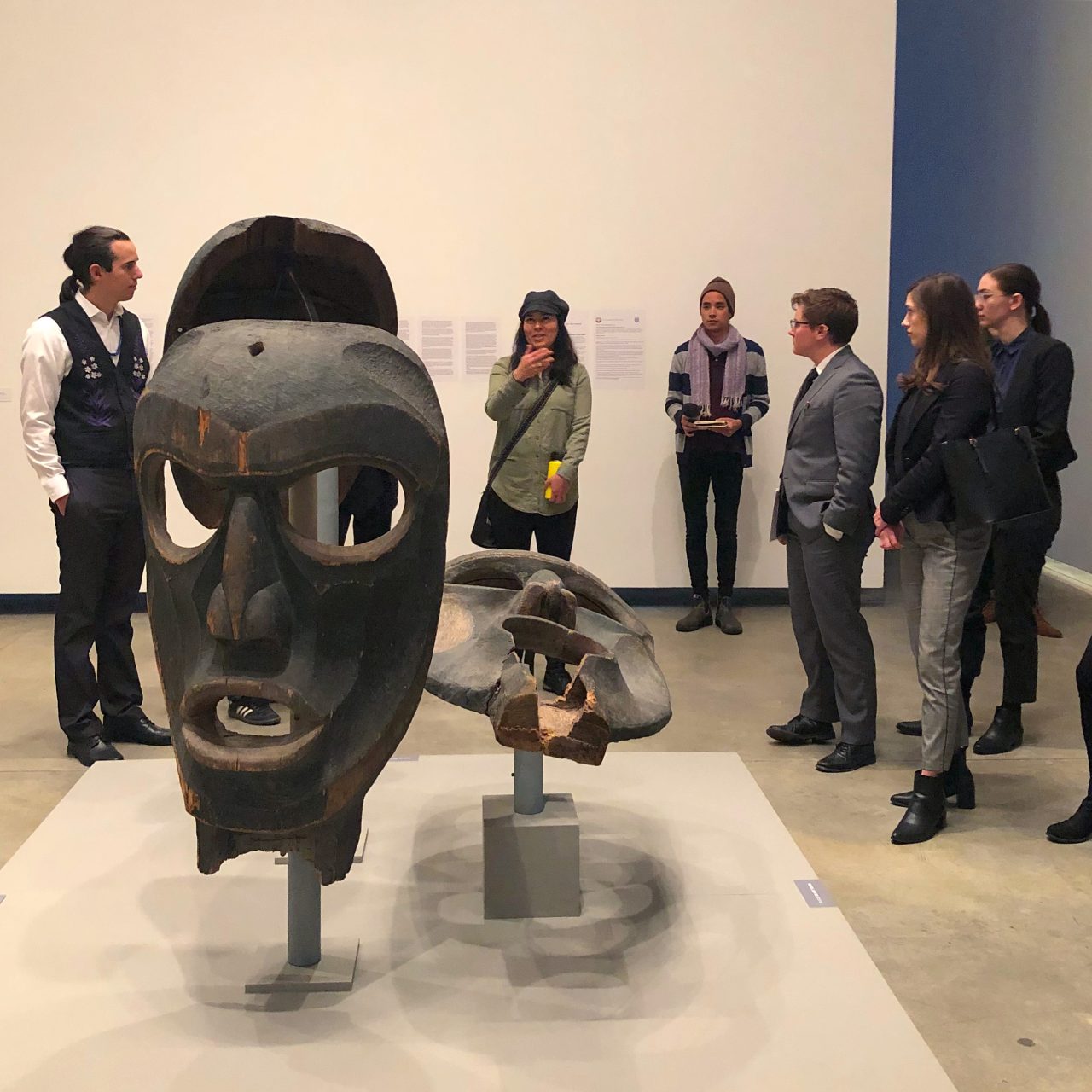2017 – 2020
Exterior of the Belkin
Marianne Nicolson: The Sun is Setting on the British Empire
-
Marianne Nicolson
ArtistMarianne Nicolson (Kwakwa̱ka̱’wakw, Musga̱maḵw Dzawada̱’enux̱w First Nations, b. 1969) is an artist and activist of the Musga̱maḵw Dzawada̱’enux̱w Nations who are part of the Kwakwa̱ka̱’wakw (Kwak’wala speaking peoples) of the Northwest Coast. She is trained in both traditional Kwakwa̱ka̱’wakw forms and culture and contemporary gallery and museum-based practice. Her practice is multi-disciplinary, encompassing photography, painting, carving, video, installation, monumental public art, writing and speaking. She works as a Kwakwaka’wakw cultural researcher and historian, as well as an advocate for Indigenous land rights. She holds a BFA from the Emily Carr University of Art and Design (1996), an MFA (2000), MA in Linguistics and Anthropology (2005) and PhD in Linguistics and Anthropology with a focus on space as expressed in the Kwak’wala language (2013) all from the University of Victoria. Solo exhibitions include the Art Gallery of Greater Victoria (2008); Artspeak, Vancouver (2006); Esquimalt Municipal Hall (2004); Thunder Bay Art Gallery (2002); National Indian Art Centre, Hull (2001); Campbell River Public Art Gallery (2000) and Or Gallery, Vancouver (1992). Group exhibitions include the 17th Biennale of Sydney (2020); the Morris and Helen Belkin Art Gallery, Vancouver (2020); the Vancouver Art Gallery (2019-20); the National Gallery of Canada, Ottawa (2018-19) and the National Museum of the American Indian, New York (2017-19), among others. Major monumental public artworks are situated in her home territory of the Musga̱maḵw Dzawada̱’enux̱w First Nation, Vancouver International Airport, the Canadian Embassy in Amman, Jordan and the Canadian Embassy in Paris, France.
Following Nicolson’s Hexsa’a̱m: To Be Here Always, a 2019 project with the Belkin that functioned as research, material, media, testimony and ceremony to challenge the western concept that the power of art as limited to the symbolic, This Is An Emergency Broadcast (2023) is another moment to amplify Indigenous tradition.
Read More
Commissioned for the exhibition To refuse/To wait/To sleep (January 13-April 9, 2017), Marianne Nicolson reworks the British Columbia provincial flag by repositioning and inverting the Union Jack below a setting/rising sun that has been recreated with a Pacific Northwest Coast Indigenous aesthetic. Nicolson references the flag’s original orientation (1895-1906); while the early version shows the sun atop the Union Jack and suggests a cooperative situation and mutually beneficial alliances between the crown and Indigenous nations, these emblems were reversed in1906 and symbolically reveal a relationship of oppression, theft and genocide. By righting the symbols of the flag back to their original relationship, Nicolson’s banner invigorates the hope for and assertion of Indigenous rights over the land, which today remain largely unresolved.
Marianne Nicolson’s banner was installed on the exterior of the Belkin Art Gallery from 2017 to 2020; it was removed in anticipation of a new banner as part of Soundings: An Exhibition in Five Parts (September 8-December 6, 2020), which was delayed due to the COVID-19 pandemic and is still being researched. From 2011 to 2016, Luis Camnitzer’s The Museum Is a School (2010/11) was installed as part of the artist’s exhibition at the Gallery (September 30-December 4, 2011), with the words, “The Museum Is a School: The Artist Learns to Communicate, the Public Learns to Make Connections.” From 2005 to 2010, Jamelie Hassan’s Because … there was and there wasn’t a city of Baghdad (1991) hung on the exterior of the building, which originally was conceived in response to the Gulf War and featured a photograph Hassan took on her first visit to Baghdad in the late 1970s. Hassan’s work is part of the Belkin’s permanent collection. The Sun is Setting on the British Empire was commissioned and installed with the support of the Audain Foundation, 2017.
-
Marianne Nicolson
ArtistMarianne Nicolson (Kwakwa̱ka̱’wakw, Musga̱maḵw Dzawada̱’enux̱w First Nations, b. 1969) is an artist and activist of the Musga̱maḵw Dzawada̱’enux̱w Nations who are part of the Kwakwa̱ka̱’wakw (Kwak’wala speaking peoples) of the Northwest Coast. She is trained in both traditional Kwakwa̱ka̱’wakw forms and culture and contemporary gallery and museum-based practice. Her practice is multi-disciplinary, encompassing photography, painting, carving, video, installation, monumental public art, writing and speaking. She works as a Kwakwaka’wakw cultural researcher and historian, as well as an advocate for Indigenous land rights. She holds a BFA from the Emily Carr University of Art and Design (1996), an MFA (2000), MA in Linguistics and Anthropology (2005) and PhD in Linguistics and Anthropology with a focus on space as expressed in the Kwak’wala language (2013) all from the University of Victoria. Solo exhibitions include the Art Gallery of Greater Victoria (2008); Artspeak, Vancouver (2006); Esquimalt Municipal Hall (2004); Thunder Bay Art Gallery (2002); National Indian Art Centre, Hull (2001); Campbell River Public Art Gallery (2000) and Or Gallery, Vancouver (1992). Group exhibitions include the 17th Biennale of Sydney (2020); the Morris and Helen Belkin Art Gallery, Vancouver (2020); the Vancouver Art Gallery (2019-20); the National Gallery of Canada, Ottawa (2018-19) and the National Museum of the American Indian, New York (2017-19), among others. Major monumental public artworks are situated in her home territory of the Musga̱maḵw Dzawada̱’enux̱w First Nation, Vancouver International Airport, the Canadian Embassy in Amman, Jordan and the Canadian Embassy in Paris, France.
Following Nicolson’s Hexsa’a̱m: To Be Here Always, a 2019 project with the Belkin that functioned as research, material, media, testimony and ceremony to challenge the western concept that the power of art as limited to the symbolic, This Is An Emergency Broadcast (2023) is another moment to amplify Indigenous tradition.
Read More
Related
-
Event
25 Mar 2017, 1 pm
Artist Talk: Marianne Nicolson
Join artist Marianne Nicolson who will talk about two works in the exhibition To refuse/To wait/To sleep, Tunics of the Changing Tide (2007) in the Walter C. Koerner Library and The Sun is Setting on the British Empire (2016) on the facade of the Belkin Art Gallery. Watch the talk online.
[more] -
Event
25 Mar 2017, 2 pm
Catalogue Launch: To refuse/To wait/To sleep
In conjunction with the book launch, Marianne Nicolson will be presenting an artist talk beginning at 1 pm in the Gallery. [Read more...] <http://belkin.ubc.ca/events/marianne-nicolson-artist-talk>
[more] -
Event
29 Mar 2017, 2 pm
Concert at the Belkin: To refuse/To wait/To sleep
We are excited to welcome the UBC Contemporary Players back to the Belkin Art Gallery for a concert inspired by the exhibitions To refuse/To wait/To sleep and M&A. The program will showcase original compositions written specifically for the ensemble by UBC composers, as well as a new improvised work developed through workshops with visiting artist Douglas Finch. Led by directors Corey Hamm and Paolo Bortolussi with coaching support from Laine Longton, this graduate and undergraduate music ensemble from the UBC School of music will animate the Gallery for an afternoon program exploring themes from the exhibition including a range of affective expressions of late capitalism.
[more] -
Event
12 January 2017
Curator Tour: To refuse/To wait/To sleep with Lorna Brown
Curator Lorna Brown will discuss the exhibition To refuse/To wait/To sleep, which is presented alongside M&A. Watch the talk online.
[more] -
Event
13 Jan 2017, 3-9 pm
Symposium: To refuse/To wait/To sleep and M&A
This symposium is occasioned by the To refuse/To wait/To sleep and M&A exhibitions at the Morris and Helen Belkin Art Gallery. The paradoxical nature of money means that it has long been of interest to artists. Money’s tense and ever-changing relationship with the spiritual and material worlds are echoed in the visual arts - both money and art seem to have the capacity to conjure substance and value out of nothing. Although the relationship between the visual or performance arts and money is an old one, it is only relatively recently that artists have produced works that seek in some way to emulate or model economic practices. Both visual and performance artists are increasingly using their work to explicitly reflect upon the economic conditions in which it is being created. This has intensified in recent years as contemporary art has become ever more closely associated with high finance, appearing more and more as a global industry in its own right.
[more] -
Tour
13 January-9 April 2017
Tours: To refuse/To wait/To sleep and M&A

Tours and discussions of To refuse/To wait/To sleep can be arranged from Tuesday to Friday for groups and classes, lasting 50 minutes and longer. For more information, please contact Belkin Public Programs by email at belkin.tours@ubc.ca or by phone at (604) 822-5600. Drop-in tours are available on Saturday and Sunday between 12:30 and 4 pm. Drop-in tours are casual and conversational, lasting about 15-30 minutes. These can be arranged the day-of at the Reception Desk or ahead of time by calling (604) 822-4883.
[more] -
Exhibition
13 January 2017 – 9 April 2017
To refuse/To wait/To sleep M&A

To refuse/To wait/To sleep and M&A bring together work by Goldin+Senneby, Melanie Gilligan, Gabrielle Hill, Richard Ibghy & Marilou Lemmens, Marianne Nicolson and Raqs Media Collective to investigate belief and prediction in economic models, precarious labour and illicit and marginalized markets. Speculative and experimental, their work tests models, forecasts futures and examines histories of exchange and the limits of productivity. In the context of knowledge-based economies, student debt and the outsourcing of intellectual labour, the exhibition aims to draw forth dialogues about how we imagine individual and collective futures in the “new normal.”A
[more] -
Tour
19 January - 7 April 2019 from 12:30-4 pm
Tours: Hexsa’a̱m: To Be Here Always

Tours and discussions can be arranged from Tuesday to Friday for groups and classes, lasting 50 minutes and longer. For details and information, email naomi.sawada@ubc.ca or call 604-822-3640. Drop-in tours are available on Saturday and Sunday between 12:30 and 4 pm. Drop-in tours are casual and conversational, lasting about 15-30 minutes. These can be arranged the day-of at the Reception Desk or ahead of time by calling 604-822-4883.
Photo: Scy Krogh.
[more] -
Exhibition
11 January 2019 – 7 April 2019
Hexsa’a̱m: To Be Here Always

Working together at Kingcome Inlet in Summer 2018, a group of artists used film, video, social media, weaving, animation, drawing, language and song to address the urgent threats to the land and water. A manifestation of the relationships formed between the participants over this past year, Hexsa’a̱m: To Be Here Always is based on sharing knowledge and respectful collaboration. Simultaneously research, material, media, testimony and ceremony, the exhibit challenges the western concept that the power of art and culture are limited to the symbolic or metaphoric, and that the practices of First Peoples are simply part of a past heritage. As Marianne Nicolson states, “We must not seek to erase the influence of globalizing Western culture, but master its forces selectively, as part of a wider Canadian and global community, for the health of the land and the cultures it supports. The embodied practice of ceremonial knowledge relates to artistic experience – not in the aesthetic sense, but in the performative: through gestures that consolidate and enhance knowledge for positive change.” Hexsa’a̱m: To Be Here Always positions the gallery as an active location for this performance, drawing together many faculties and disciplines of the university in generative exchange.
[more]